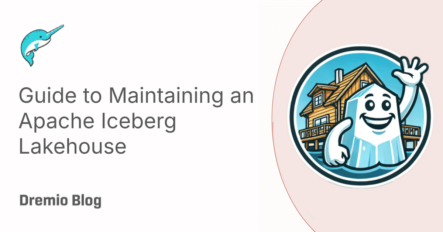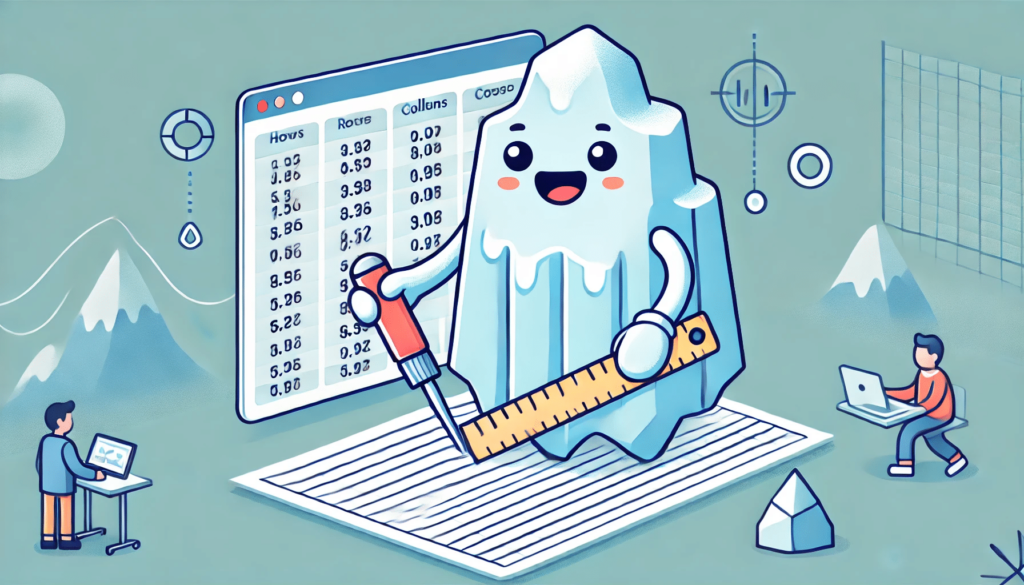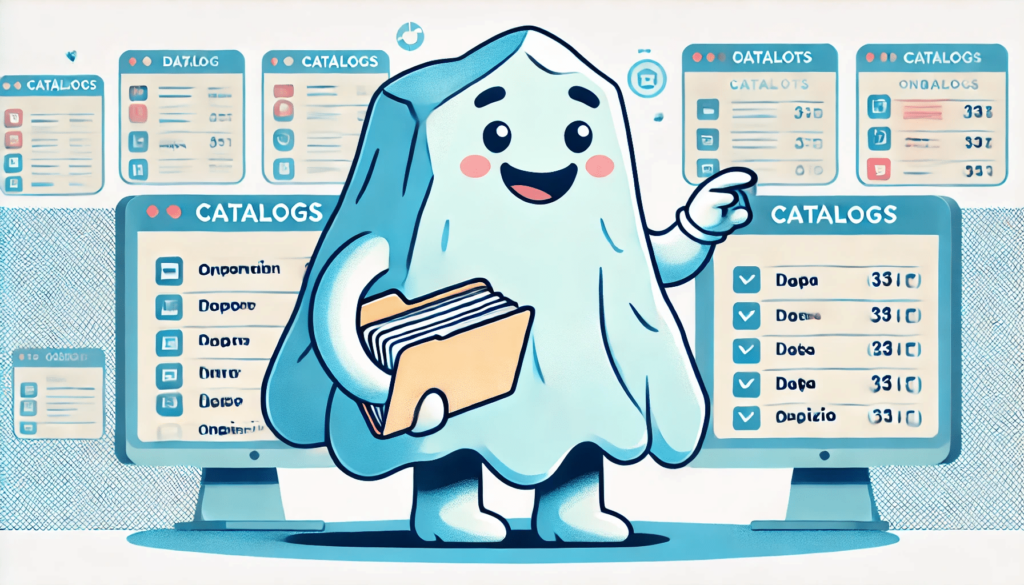23 minute read · August 12, 2024
Guide to Maintaining an Apache Iceberg Lakehouse
· Head of DevRel, Dremio

Data Lakehouse architecture has been the direction of data platform evolution over the last several years. By making your data platform more flexible, allowing you to use all your favorite tools on openly accessible tables in a data lake, you can enhance performance, reduce time-to-insight, and lower costs. However, in a modular or deconstructed warehouse environment like a data lakehouse, much of the maintenance and optimization that typically happens behind the scenes in a tightly coupled, closed system now becomes the responsibility of the platform team. In this article, we'll discuss the key considerations for creating a maintainable and scalable lakehouse centered around Apache Iceberg tables. So, this maintenance guide and the previously published migration guide should help make the path to an Iceberg Lakehouse clear and practical.
Free Iceberg Resources
Download a Free Copy of Apache Iceberg: “The Definitive Guide”
Register for the Free Apache Iceberg Crash Course
The Components of Data Lakehouse and The Work to Maintain It
A data lakehouse is composed of five modular components:
- Storage (Data Lake): This is where you store your structured and unstructured data, typically in a distributed storage system. These systems can be block-based, like Hadoop, or object storage systems like S3, ADLS, Vast Storage, Minio, Pure Storage, and NetApp StorageGRID.
- Data Files: These are the files that contain your data, stored in your data lake. For lakehouse tables, these files are most often Apache Parquet files, a binary columnar file format optimized for storing data for analytics.
- Table Format: A single dataset can be comprised of many Parquet files. To allow systems to understand this group of files as a unified dataset, metadata layers like Apache Iceberg are used. These layers store metadata alongside your data on the data lake, enabling tools to treat the data as a standard database table, complete with database-like ACID guarantees and evolution capabilities.
- Catalog: The catalog functions as a directory of your tables, making them easily discoverable by various tools. It also serves as a governance layer for those tables, operating independently of the specific tool accessing the data.
- Compute: This includes tools like Dremio, Snowflake, Upsolver, Apache Spark, Apache Flink, and others that read and write to the tables in your lakehouse. These tools often offer additional features for ingestion, governance, acceleration, and data product development, enhancing the usability of your lakehouse.
When managing a data lakehouse, there are several key considerations:
- Optimizing Individual Tables
- Cleaning Up/Hard Deleting Unnecessary Files
- Catalog Management
- Role-Based Access Controls
- Fine-Grained Access Controls

Optimizing Individual Tables
Apache Iceberg metadata enhances the speed of table scans by allowing the system to skip data files that contain no relevant information for the query. However, despite this metadata advantage, if you don't effectively partition your table, run compaction to reduce the number of files, and leverage clustering to organize data by heavily queried fields within those files, you risk leaving significant performance gains on the table.
Partitioning
Partitioning is essential to how your table is defined, allowing data with distinct values in a particular field to be written to separate files. You typically want to partition a table based on a frequently filtered field. For example, imagine having a dataset of all voters in the United States. If you regularly filter by political party, this field would be a good candidate for partitioning. By partitioning this field, all records for voters in the Yellow Party would be written to different data files than those for the Blue, Red, or Green parties. This way, if a user queries only for Green Party voters, the engine can skip all the data files containing Blue, Red, and Yellow voters.
However, this approach can lead to challenges. If one partition contains significantly more data than another, you may encounter "skew," where queries that include the larger partition take longer to execute. Conversely, if a particular partition doesn’t receive data as frequently, you might face the "small files problem," where the partition has the same amount of data but is spread across more files, slowing down planning and scanning.
Using Apache Iceberg metadata tables, you can monitor the size of your partitions to avoid or manage skew, and with compaction, as discussed later, you can eliminate the small files problem. Apache Iceberg also offers valuable features for partitioning, such as Hidden Partitioning and Partition Evolution, which enhance the overall management and efficiency of your data.
Compaction
The small files problem occurs when a partition has many small files rather than fewer, larger files. This can happen when writing frequent small bits of data from regular batches or streaming. This fragmentation can significantly degrade query performance, as it increases the overhead for both metadata management and file access. Each file, regardless of its size, incurs an I/O cost when opened, and when there are too many small files, these costs accumulate, leading to slower query execution.
Compaction is the primary solution to the small files problem. Compaction reduces the number of small files by merging them into larger files, thus improving query performance and reducing metadata overhead. In the context of Apache Iceberg, tools like Apache Spark’s rewrite_data_files procedure and Dremio’s OPTIMIZE command offer robust methods for performing compaction.
The Apache Spark rewrite_data_files procedure allows you to combine small files into larger ones, thus reducing the metadata load and the runtime file opening costs. This procedure can be customized with various options, such as specifying a target file size, sorting the data within the files, or even focusing the rewrite on specific partitions. For example, you can filter partitions to target only those that require compaction, which can significantly speed up the process, especially in large datasets. Additionally, the procedure can be configured to handle partial progress and optimize resource usage during the compaction process.
On the other hand, Dremio’s OPTIMIZE command provides a similar functionality. It rewrites data and manifest files to achieve an optimal size, either by combining smaller files or splitting larger ones using a bin-packing strategy. Like Spark’s procedure, Dremio’s OPTIMIZE command also allows for filtering specific partitions to streamline the compaction process. This feature is handy for scenarios where only a subset of partitions requires optimization, ensuring that the operation is both time-efficient and resource-efficient.
You can apply filters to target specific partitions that need compaction to achieve faster compaction performance. This approach reduces the scope of the operation, allowing for quicker execution and less resource consumption. Adjusting the min-input-files parameter can help you control when compaction is triggered, ensuring the process is performed only when beneficial. Monitoring partition sizes using Iceberg’s metadata tables can also help you determine the optimal timing and configuration for compaction tasks.
Clustering
Sorting and clustering your data can significantly enhance query performance in a data lakehouse environment. When creating a table, you can define a local sort order that instructs the engine to sort the data within each task before it is written into a data file. This initial sorting step ensures that related data is stored within each data file, which can speed up query processing by reducing the amount of data that needs to be scanned.
However, sorting and clustering the data doesn't have to be limited to the table creation. Even after the data has been written, you can optimize its organization further using the Spark rewrite_data_files procedure. During compaction, this procedure allows you to sort the data across fewer files, effectively clustering related data. Doing so reduces the number of files the engine needs to scan during queries, leading to faster query execution times.
Clustering data through sorting during compaction can be particularly beneficial for tables that are frequently queried on specific fields. For example, if your queries often filter on a date range or a particular category, clustering the data by these fields ensures that the relevant data is grouped in fewer files. This clustering reduces the amount of unnecessary data scanned during queries, improving performance and reducing the overall resource consumption of your lakehouse.

Cleaning Up Files
While compaction and partitioning play crucial roles in structuring your table's data for faster reads, managing the storage footprint of your Iceberg tables is equally important. As you continue to add more snapshots to your tables, you'll notice that your storage usage increases because files are only deleted when specific cleanup operations are performed. Let’s explore some of these essential cleanup operations.
Expiring Snapshots
Expiring snapshots is a crucial aspect of managing the storage footprint of your Apache Iceberg tables. A new snapshot is created each time you perform a write, update, delete, upsert, or compaction operation on an Iceberg table. While these snapshots are invaluable for features like snapshot isolation and time travel, they can quickly increase storage consumption if not appropriately managed. Each snapshot retains references to data and metadata files that may no longer be needed once newer snapshots are created. Your storage usage can balloon without regular cleanup, affecting costs and performance.
The expire_snapshots procedure in Apache Spark and the VACUUM TABLE command in Dremio are tools designed to manage this aspect of your data lakehouse. These commands help by removing older snapshots that are no longer necessary, along with the data files, manifest files, and other metadata associated with them. The logic behind these commands is straightforward yet effective: they use metadata to generate a list of files in all valid snapshots before and after the expiration operation. Files no longer present in the current set of snapshots are then safely deleted, freeing up valuable storage space.
Running these operations regularly is essential to maintaining an efficient and cost-effective data lakehouse. By removing outdated snapshots, you reclaim storage and reduce associated costs. Moreover, having a clear data retention policy that defines how long snapshots should be retained is vital for ensuring compliance with regulations like GDPR, which mandate the hard deletion of personally identifiable information (PII). Regularly expiring snapshots and deleting obsolete files helps you meet these regulatory requirements while optimizing your data platform.
For instance, with the expire_snapshots procedure in Apache Spark, you can specify parameters such as older_than to remove snapshots older than a particular date, or retain_last to ensure that a minimum number of recent snapshots are preserved. Similarly, Dremio's VACUUM TABLE command allows you to expire snapshots based on time thresholds or a specified number of most recent snapshots, providing flexibility in how you manage your data.
Orphan Files
Orphan files are files that aren't attached to any snapshot or metadata record due to failed or incomplete writes, accidental data copying, or other disruptions during data operations. Because they are not associated with any snapshot, these files are not automatically cleaned up when you expire snapshots, leading to wasted storage space and potential clutter in your data lake.
The remove_orphan_files procedure in Apache Spark is specifically designed to address this issue. This procedure scans the directories associated with your Iceberg table to identify files that are not referenced by any snapshot or metadata file. These orphan files can then be safely removed to reclaim storage and maintain a clean, efficient data environment.
However, because orphan files are not tied to any specific snapshot, the process of identifying them can be more time-consuming. The procedure works by comparing the files in your storage against the list of files tracked by your Iceberg table’s metadata. Since this operation involves a comprehensive scan of your storage directories, it is more resource-intensive and should be run less frequently than other cleanup operations like expiring snapshots.
When using the remove_orphan_files procedure, you can specify parameters such as older_than to target files created before a certain date, or location to focus on specific directories. There is also a dry_run option, which allows you to identify potential orphan files without actually deleting them, providing an opportunity to review the results before taking action.
Running this procedure regularly, albeit less frequently, is essential for maintaining the health of your data lakehouse. If left unchecked, orphan files can accumulate over time, leading to increased storage costs and potential confusion when managing your data. By periodically cleaning up these files, you ensure that your data lakehouse remains streamlined and that your storage is used efficiently.

Catalog Management
Iceberg Catalogs are a crucial component of an Iceberg Lakehouse, serving as the backbone for tracking the names of your tables and linking them to the file locations of their latest metadata. The catalog essentially acts as a directory, enabling tools to easily discover and interact with your datasets, while also ensuring that each table is properly organized and accessible.
You have several options when it comes to choosing an Iceberg Catalog. One route is to leverage open-source catalogs like Nessie and Polaris. These catalogs adhere to open standards, providing greater flexibility and reducing vendor lock-in. However, using these open-source solutions typically requires you to deploy and manage the necessary infrastructure, which can add complexity to your operations.
Alternatively, you can opt for managed solutions based on these open standards, such as Dremio's Enterprise Catalog. Managed solutions eliminate the need to oversee catalog infrastructure, freeing up your resources to focus on other aspects of your data lakehouse. Additionally, Dremio's Enterprise Catalog offers the ability to automate many of the optimizations we've discussed earlier, such as compaction, snapshot expiration, and orphan file removal. This automation ensures that your data remains optimized and performant without manual intervention, making it an attractive option for organizations looking to streamline their data management processes.

Role-Based Access Controls
Role-Based Access Control (RBAC) is a fundamental security feature that restricts access to resources based on the credentials of the user or the roles they are associated with. Essentially, RBAC ensures that only authorized users or roles can access specific data, providing a crucial layer of security and governance in your data lakehouse. When a user or system attempts to access a resource, RBAC checks are performed before any data is retrieved, ensuring that access is granted only to those with the appropriate permissions.
While RBAC is traditionally implemented within individual data engines like Dremio and Snowflake, there is a growing movement to integrate RBAC into the catalog layer itself. By embedding RBAC within the catalog, your access control rules become portable and consistent across different tools and environments. This approach simplifies governance by ensuring that your security policies are applied uniformly, regardless of which tool is accessing the data.
Guidance on Designing Effective RBAC Rules
- Principle of Least Privilege: Start by granting users the minimum level of access necessary to perform their tasks. Avoid giving broad or unnecessary permissions that could expose sensitive data or allow unintended actions.
- Role Hierarchies: Design your roles in a hierarchical manner, where higher-level roles inherit the permissions of lower-level roles. This approach simplifies permission management and reduces the complexity of assigning roles as users move within the organization.
- Segregation of Duties: Ensure that your RBAC rules enforce a clear separation of duties. For example, roles that perform auditing or monitoring should not have the ability to modify data. This reduces the risk of unauthorized changes and helps maintain data integrity.
- Regular Audits and Reviews: Periodically review and audit your RBAC rules to ensure they still align with your organization’s needs. As roles and responsibilities evolve, access requirements may change, and it’s crucial to keep your RBAC rules up-to-date.
- Test RBAC Configurations: Before deploying RBAC rules into a production environment, thoroughly test them to ensure that they behave as expected. This helps prevent unintended access issues or disruptions to users’ workflows.
- Documentation: Maintain clear and detailed documentation of your RBAC policies, including the rationale behind specific roles and permissions. This documentation will be invaluable for onboarding new users, conducting audits, and troubleshooting access issues.

Fine-Grained Access Controls
Fine-Grained Access Controls (FGAC) provide a more detailed level of security by restricting access to individual rows or columns within a dataset. Unlike Role-Based Access Control (RBAC), which typically governs access at a higher level (such as entire tables or databases), FGAC allows you to enforce access policies that determine which specific pieces of data a user or role can see or interact with.
To apply FGAC, the system must first access the actual data to evaluate and apply filters at the row or column level. This process involves testing each piece of data against the defined access rules and filtering out any data that the user is not permitted to view. Because FGAC requires this deep interaction with the data, it is much less practical to implement in a portable way across different tools or environments. Unlike RBAC, which can potentially be applied at the catalog level, FGAC tends to be more tightly coupled with the specific engine or tool that is accessing the data.
This limitation highlights the importance of choosing the right tool for enforcing FGAC across your data ecosystem. Using a tool like Dremio as your primary access layer can be particularly advantageous. Dremio allows you to connect all your data lakes, databases, data warehouses, and Iceberg catalogs into a single platform. By centralizing access through Dremio, you gain the ability to enforce FGAC consistently across all your data sources. This unified interface simplifies management and ensures that fine-grained security policies are applied uniformly, regardless of where the data resides.

Conclusion
Maintaining an Apache Iceberg Lakehouse involves strategic optimization and vigilant governance across its core components—storage, data files, table formats, catalogs, and compute engines. Key tasks like partitioning, compaction, and clustering enhance performance, while regular maintenance such as expiring snapshots and removing orphan files helps manage storage and ensures compliance. Effective catalog management, whether through open-source or managed solutions like Dremio's Enterprise Catalog, simplifies data organization and access. Security is fortified with Role-Based Access Control (RBAC) for broad protections and Fine-Grained Access Controls (FGAC) for detailed security, with tools like Dremio enabling consistent enforcement across your data ecosystem. By following these practices, you can build a scalable, efficient, and secure Iceberg Lakehouse tailored to your organization's needs.
Schedule a free meeting with us so we can help you with your Apache Iceberg journey!
Some Exercises to Get Hands-on with Apache Iceberg, Dremio, and More!
- Intro to Nessie, and Apache Iceberg on Your Laptop
- From SQLServer -> Apache Iceberg -> BI Dashboard
- From MongoDB -> Apache Iceberg -> BI Dashboard
- From Postgres -> Apache Iceberg -> BI Dashboard
- From MySQL -> Apache Iceberg -> BI Dashboard
- From Elasticsearch -> Apache Iceberg -> BI Dashboard
- From Kafka -> Apache Iceberg -> Dremio
Sign up for AI Ready Data content


